Climate Change Report
Climate Change Report aligned with the recommendations of the Task Force on Climate Related Financial Disclosures
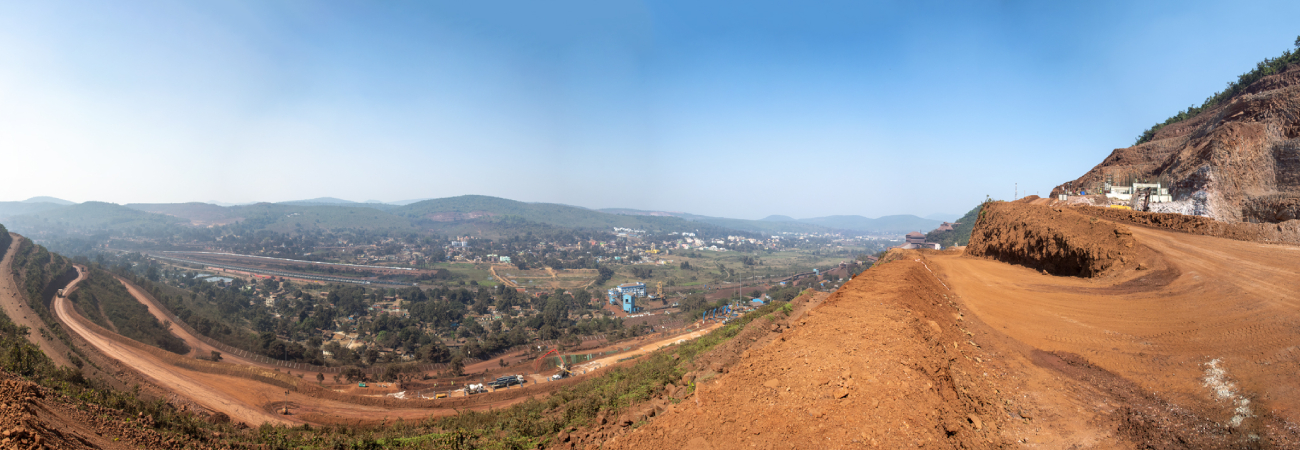
Committed to sustainable mining
Steel will continue to be a foundation material globally as the world transitions to a low carbon economy. It has wide scale applications for renewable energy, low-CO2 transportation, large-scale hydrogen production and distribution, carbon capture, usage & storage, electric vehicles, sustainable buildings and delivering major infrastructure projects which will help nations to achieve their climate goals.
At the same time, it is important to recognise that the steel making industry is a hard to abate sector, as 70% of global production is through the blast furnace route which relies on coal. This traditional technology has had the benefit of cost competitiveness, energy efficiency (as coal is both a reductant and source of energy) and the ability to produce value added and differentiated grades of steel. Around 30% of global steel production uses the Electric Arc Furnace (EAF) and can use scrap as feedstock. This has less carbon intensity than the Blast Furnace route but consumes more electricity and is not yet able to produce the entire range of value-added grades of steel. Moreover, the majority of global scrap is generated in economically mature regions (like USA, Europe), with a history of significant legacy investments in infrastructure.
Steelmakers around the world are faced with the challenge of adopting a pathway towards reduction of the emission intensity of their produced steel. The pathways would have to be contextualised on the appropriateness of resource availability in relevant geographies, a just transition in the ecosystem and supply chain, and a viable technological solution that is financially sustainable. The financial investments required for progressing towards net zero will be very significant and require three critical enablers:
- availability of fiscal support to make the transition viable and affordable
- policy support towards infrastructure development for new energy
- the value chain’s demand for low carbon greener steel products. A number of the potential
A number of the potential technology solutions are being evaluated for decarbonisation and are at various stages of development. It is expected that a bouquet of solutions would emerge over the next decade.
As a responsible corporate citizen, Tata Steel has always placed strong emphasis on environment, social and governance aspects while designing its corporate strategy across all its business operations. In the FY 2022-23 (Global Comment), the Company adopted the target to be net zero across its entire global operations by the year 2045. This is also in line with the Tata Group target as part of Project Alingana (embrace sustainability) and is an ambitious endeavour underlining the Company’s strong commitment to sustainability. Tata Steel is seeking to put in place bespoke de-carbonisation plans for our steelmaking operations in India and Europe that are anchored around the demand for low carbon steel products in the individual geographies, the regulatory development in the region, availability of viable transition options and fiscal and policy support for the transition. Tata Steel continues to promote circularity and in addition to our electric arc based steel making facilities in Thailand that recycles steel scrap and have very low CO2 emission intensity, in India too, the Company has taken the initiative to set up its first scrap based greenfield EAF steelmaking facility in Punjab. We will continue to look at expanding the same process route in other locations in India. The Company is currently working on the pathway towards its Net Zero target as it evaluates investment priorities towards stakeholder value creation, climate targets and growth in the long term.
A. Recommendations of the Task Force on Climate Related Financial Disclosures
After the Paris Agreement in 2015, it was recognised that in order for financial markets to price climate change related risks to support informed, efficient capital-allocation decisions, financial markets need accurate and timely disclosures from companies. Accordingly, in December 2015, the Financial Stability Board and the Group of 20 (G20) countries established the Taskforce on Climate Related Financial Disclosures (TCFD) to prepare a comprehensive framework on disclosures on physical and nonphysical risks and opportunities associated with climate change. TCFD originally had 22 members comprised of preparers and users of financial disclosures, and members from both financial and non-financial companies across a range of countries and relevant areas of expertise and was chaired by Mr Michael Bloomberg. Tata Steel was one of the founder members of TCFD and is represented by its Executive Director and Chief Financial Officer on the Task Force.
Over a 2-year period, the Task Force engaged extensively with key stakeholders globally, and in 2017, TCFD issued its report detailing 11 voluntary recommendations, known as the TCFD framework. The disclosure recommendations are structured around four thematic areas that represent core elements of how companies operate: Governance, Strategy, Risk Management, and Metrices & Targets, covering the following areas:
Governance:
Board’s oversight and role of the management in Climate Risk Management.
Strategy:
Climate-related risks and opportunities, including their impact and scenario analysis.
Risk Management:
Description of processes for identifying and assessing climaterelated risks, managing them and their integration in the overall risk management.
Metrices & Targets:
Disclosure of the metrices used by the organisation to assess climate-related risks and opportunities, including Scope 1, Scope 2, and, if appropriate, Scope 3 emissions. The organisation must also disclose its targets and performance against those targets.
Since the release of the TCFD recommendations, support for TCFD has increased rapidly and TCFD now has 4,000+ supporting organisations across the public and private sectors representing over 70 industries in 101 jurisdictions with a combined market capitalisation of US$26 trillion. TCFD has also been supported by the governments of 11 countries. The International Sustainability Standards Board, under the IFRS Foundation, has also incorporated the TCFD Framework in its draft disclosure standards on climate which is scheduled to be launched in mid 2023.
As a founding member of TCFD, Tata Steel played a crucial role in the development of the TCFD standard. We are also one of the first companies in India to have adopted the recommendations of TCFD, pursuant to which we have undertaken extensive physical climate risk assessments and transition climate risk assessments using independent third party experts across all our major steelmaking sites in line with the recommendations, and incorporated them in our Enterprise Risk Management Framework.
The enclosed report is discussed under the four pillars of TCFD, i.e., Governance, Strategy, Risk Management and Metrices & Targets.
B. Governance
Tata Steel has adopted “Leadership in Sustainability” as one of its four long-term, strategic objectives. The management undertakes climate risk assessment and identification of potential mitigation actions through a cascaded process across the Company which are then reviewed by its Board of Directors. The Board has constituted specific committees (including executive directors representing the business) which take a comprehensive approach to assessing climate risks and impacts, and recommend appropriate strategies to deal with them:
- Corporate Social Responsibility and Sustainability Committee
- Safety, Health and Environment Committee
- Risk Management Committee
Within the oversight of the Board, Tata Steel’s CEO & MD chairs the Apex Environment Committee, which develops the strategic objectives, reviews and monitors actions & performance, risks and mitigation plans and new initiatives. The operating teams then develop the strategy, evaluate options, engage with relevant internal & external stakeholders, pursue responsible advocacy to shape up policy in a proactive manner and implement projects. This has been further prioritised through the creation of a Centre of Excellence (CoE) for CO2 reduction and mitigation which is chaired by a Vice President of the Company and has cross functional members from all parts of the organisation. Under Tata Steel’s Agile Way of Working (AWOW) 10 de-carbonisation projects across steel making sites in India are reviewed quarterly by the CEO & MD and the senior leadership team.
Tata Steel’s subsidiary companies have aligned themselves with Tata Steel’s climate risk strategy. While the Boards of the respective companies set their respective sustainability goals, this is done within a common framework aligned to achieve Tata Steel’s Net Zero ambition of 2045. The businesses in Europe have set themselves more accelerated decarbonisation targets given the climate regulatory framework in the European Union and the UK and societal priorities. The CEO&MD and ED&CFO of Tata Steel are also on the Boards of key subsidiary companies and facilitate the alignment of the ESG governance process across businesses and regions.
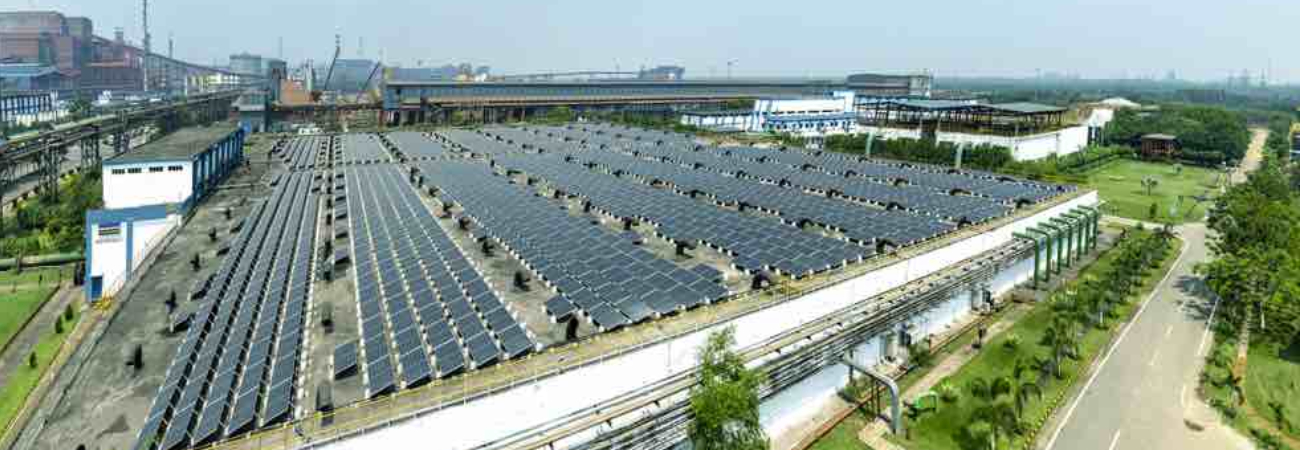
Harnessing renewable energy at Tata Steel Kalinganagar
C. Strategy
Within the overall strategic framework of transition to low carbon business configuration, Tata Steel’s decarbonisation pathway is nuanced in each geography based on local regulatory context, policy support, availability of competitively priced green energy and the associated delivery infrastructure and customers’ willingness to pay for green steel.
India
Tata Steel currently has an installed capacity of 21.6 MnTPA of steelmaking in India across its production sites. These include three major sites Jamshedpur (11 MnTPA), Kalinganagar (3 MnTPA) and Meramandali (5.6 MnTPA), all of which consume iron ore and coking coal in blast furnaces to produce steel. In FY2022-23, Tata Steel completed the acquisition of Neelachal Ispat Nigam Limited (NINL), which neighbours Tata Steel’s Kalinganagar site, has now ramped up production at NINL to 1 MnTPA, and is also reliant on blast furnace technology. Finally, through Tata Steel Long Products, Tata Steel operates 1 MnTPA of EAF technology to produce speciality long products at its Gamharia site in Jamshedpur and this too is fed by hot metal.
India is currently the second-largest steel-producing country in the world. The National Steel Policy of India envisages 300 MnTPA steel production in India by 2030, and local demand is expected to continue to increase 4-5 times of current levels by the middle of this century. Accordingly, Tata Steel has a stated ambition to double its steelmaking capacity in India to 40 MnTPA.
This growth trajectory poses its own decarbonisation challenges for the largely blast furnace based Indian steel industry. Currently, the constraint is the availability of competitively priced low carbon fuel (Green Hydrogen and Natural Gas) and the associated delivery infrastructure, to enable viability of such technologies at scale. The relatively low level of embedded steel within the country’s steel intensive assets like infrastructure, automotive and consumer goods indicates a low rate of scrap recovery from the supply chain in the medium term as the endof-life steel recovery will take some time to mature. On the other hand, local iron ore reserves present a more natural and viable input for steel making. Carbon capture and storage technologies are nascent while technology solutions for substitution of carbon in blast furnaces are at a pilot or concept stage. Finally, there is no regulated market or defined allocation of carbon credits to industry in India yet, which will have to be the first step towards creating an economic framework and the foundation for the investment thesis for de-carbonisation.
Tata Steel’s transition strategy will seek to progressively reduce reliance on fossil fuels in India:
Short-term (upto 2025)
- Entry into the steel recycling business to accelerate the transition to a completely circular economic model for steel in India.
- Utilisation of higher amounts of scrap in its existing ore-based steelmaking process assets.
- Relentless optimisation of the energy intensity and carbon intensity of existing assets through the adoption of best available technologies.
- Improving quality of raw material (iron ore and coking coal).
- Increasing share of renewable energy in the power mix.
Medium-term (2026 – 2030)
- Capacity addition in India using the scrap-based Electric Arc Furnace (EAF) route.
- Shifting from metallurgical coal to fuels with lower CO2 emissions intensities such as natural gas/<>coal bed methane.
- Upscaling pilots of Carbon Capture Utilisation & Storage (CCUS) and Hydrogen-based steelmaking.
- Piloting new technologies in partnership with academia on pilot projects which are currently at low Technology Readiness Levels (TRL).
Long-term (2031 – 2045)
- Scale up of HIsarna direct smelting technology.
- Adoption of a Direct Reduced Iron (DRI) route of ore-based production capable of operating with present day and future reductants. e.g., natural gas/coal bed methane or syngas from coal gasification or hydrogen.
- Sustainable production, storage, and use of Green Hydrogen across the steel value chain.
- CCUS dovetailing with existing processes.
- Research on advanced materials.
- Collaboration with technology companies & academia.
Tata Steel is entering into an agreement with Tata Power Renewable Energy Limited to set up solar & wind hybrid power to replace ~379 MW of Tata Steel’s fossil fuel based power consumption, thereby enabling reduction of over 2 million tonnes of CO2 emissions per annum.
As part of Tata Steel’s long-term strategy, while ore-based steelmaking will remain the predominant means of production within Tata Steel’s Indian operations, the Company has also taken a leadership position in setting up a scrap recycling business. The Company plans to set up modular EAF capacities to produce long-products facilities utilising scrap, as the scrap supply chain matures. The Company has already signed a Memorandum of Understanding with the Government of Punjab to set up a 0.75MnTPA EAF steel plant at Ludhiana, Punjab at an investment of ₹2,600 crore.
The two low-CO2 candidate technologies for ore-based steel production that is likely to become scalable in the mid-term are:
(i) retrofitting existing blast furnace-based facilities with CCUS and, (ii) DRI with green hydrogen, supplemented with the installation of EAF-type melting facilities for DRI. Tata Steel has identified both technologies as R&D leadership focus areas and is actively engaging with technology providers, academia and other companies on their development and scale-up.
The Company has successfully commissioned a pilot 5 tonne per day Carbon Capture & Utilisation (CCU) plant in Jamshedpur to capture CO2 from un-combusted blast furnace gas. The captured CO2 is being utilized for water treatment. Tata Steel has also undertaken a trial injection of hydrogen gas in ‘E’ Blast Furnace at its Jamshedpur Works in April 2023 using 40% of the injection systems, the first time in the world that such a large quantity of hydrogen has been continuously injected in a blast furnace over a period of 4-5 days. This will provide valuable insights into the potential of reduction of fossil fuel consumption and CO2 emissions upon use of greener fuels in the blast furnace. Tata Steel is also evaluating the feasibility of investments in DRI production using either natural gas/coal bed methane or syngas from coal gasification as a transitional technology until availability of green hydrogen.
Europe
Europe has taken the lead in the world both in terms of setting up a regulated carbon market to establish effective carbon emission pricing and also progressively reducing free emissions for industry to create incentives for de-carbonisation. The European Union has also announced implementation of legislation to price embedded carbon emissions in imported products at its borders, in order to prevent off-shoring of emissions. Several governments have adopted accelerated carbon emission reduction timelines, including financial incentives and penalties for industry linked to achieving them. All European steel makers are developing decarbonisation plans. The selection of technology and production routes will depend on enabling infrastructure, availability and pricing of green energy, fiscal support from governments and the willingness of markets and customers to absorb higher costs. Tata Steel is undertaking detailed engagement with local authorities and governments as we develop our transition pathways towards decarbonisation.
The Netherlands
The IJmuiden steelworks of Tata Steel Nederland BV (TSN) operates 2 blast furnaces with a steelmaking capacity of 7 MnTPA. They already rank 3rd in the global CO2 intensity benchmark 2022 study for Blast Furnace based steel producers, published by the World Steel Association. TSN, as part of its long-term sustainability strategy, has made a public commitment to reduce its CO2 emissions by 5 Megatons by 2030 and to be fully climate-neutral by 2045 via an accelerated transition process. TSN has been deeply engaged with the Dutch Government on the transition to low CO2 steel making. TSN is committed to transition out of blast furnace operations (closing both blast furnaces and coke ovens) to steel making using DRI technology and electric smelting or any other viable and scalable technology, with an eventual transition to Green Hydrogen depending on availability and economics. It is also proposed that the electric smelting technologies will run eventually on green energy. TSN is currently engaged with multiple technology and engineering partners to complete detailed evaluation and engineering, implementation planning and costing of the project. As the technology selection, the project economics and discussions with the Government of Netherlands is finalised, the Final Investment Decision proposal along with the financing framework will be developed in a time bound manner.
Tata Steel Nederland is also undertaking a comprehensive project to reduce dust and other fugitive emissions from its plant to make it future ready. It has committed to spend €300m in Roadmap+ investment programmes, including an ongoing De-NOx investment in the pellet plant (largest environment installation in a pellet plant in the world), covering bunkers and transport systems and installing dust screens, and upgraded coal filters. These projects are currently under implementation and part of the planned capital expenditure in the Company.
In Europe, we have also already launched low carbon steel products. Zeremis® Carbon Lite, is a steel with an allocated carbon footprint reduction of up to 100%. Several customers including Wuppermann, BILSTEIN, EMW Stahl Service, Arania, Permastore and Hardt Hyperloop have reached agreements to source this steel. In fact, underlining the demand for green steel in Europe, Tata Steel Nederland has already signed a Memorandum of Understanding with Ford to supply the carmaker with Zeremis® green steel once the IJmuiden steelworks switches to green hydrogen-based steelmaking.
United Kingdom
Tata Steel UK has concentrated its steel making in a single site in Port Talbot which also operates 2 blast furnaces with a capacity of 5 MnTPA. While Tata Steel UK is in the midst of evaluating strategic options for its long-term future, it also continues to pursue technologies to reduce the carbon footprint of its existing facilities. Tata Steel's programme of improvements at its blast furnaces in Port Talbot will reduce the site’s carbon footprint by about 1,60,000 tonnes of CO2 a year. At its site at Corby, it has announced a £5 million investment in State-of the Art electric induction furnaces which will reduce emissions from one of its tube mills by at least 2,000 tonnes of CO2 a year. It also launched the Shotton Sustainability Commitment in 2022 to reduce the site’s carbon footprint, develop and produce products & services that support sustainable construction, to protect and expand the biodiversity that co-exists on the site, and maximise material efficiency & achieve zero waste.
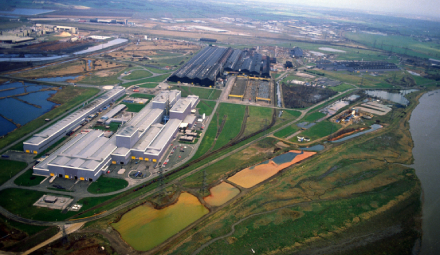
Shotton Works, Tata Steel UK
D. Risk Management
Tata Steel uses its Enterprise Risk Management process for managing climate change risks across the Company in an integrated and uniform manner. The process identifies and assesses business risks using a two-pronged approach, i.e., bottom-up and topdown, to ensure comprehensive risk identification and to minimise blind spots. Appropriate early warning indicators and mitigation strategies are identified for review by the Risk Management Committee of the Board.
Tata Steel has also undertaken a detailed and systematic assessment of Physical and Transition risks in a Climate Risk assessment focusing on its key steel making sites in India, the Netherlands and the UK. The assessment was conducted by an independent thirdparty advisor and was fully aligned with the recommendations of the Taskforce on Climate Related Financial Disclosures. The physical assessment was undertaken in line with internationally accepted and open-source data repositories for baseline natural hazard data and Climate Change Scenarios. For the assessment of transition risks in Europe, Tata Steel undertook scenario analysis as per the Net Zero Emissions by 2050 Scenario (NZE) and the Stated Policies Scenario (STEPS) whereas in India, Tata Steel used a bespoke scenario that outlines what we believe to be a technologically, industrially & economically possible route forward to holding the increase in global average temperature to below 1.5°C. It forms Tata Steel’s base scenario for analysis and its strategic considerations are based on this scenario.
Summary of Climate Related Risks for Tata Steel:

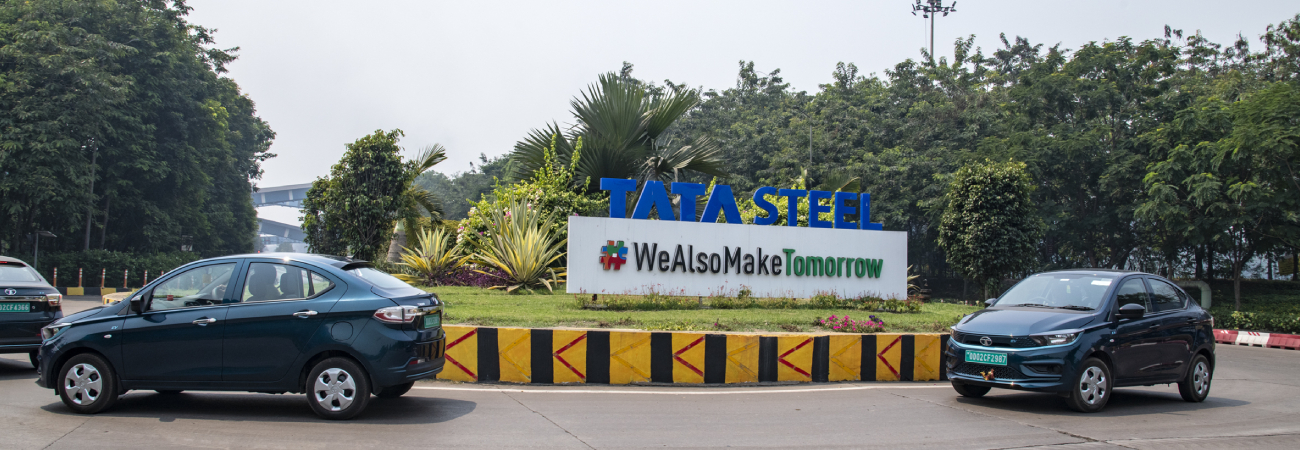
Driving towards a greener tomorrow
Opportunities for the business related to Climate Change:
New Products and Increased Revenue:
There will be an enhanced demand for high strength steels (which can be used for lightweight and carbon efficient end-user products such as cars). It is also expected that during the global transition process, early movers will be able to earn premia from sales of green steel products. Tata Steel is focussed on increasing the share of advanced high strength and green steel in its product portfolio.
Green Infrastructure:
The generation and use of green electricity depend in part on the ferromagnetic properties of steel and its alloys. Steel is a key input material for wind turbines, transmission and distribution infrastructure, hydropower, nuclear power plants etc., energy storage (steel for battery manufacturing), and transportation of green fuel (e.g., steel for pipelines for delivery of green hydrogen). Tata Steel is looking to grow and align its portfolio to be able to support the demand from the green industrial revolution.
Cost Reduction and Optimisation Opportunities:
Tata Steel is actively increasing its renewable energy capacity installations and sourcing to replace thermal power generated from fossil fuels. De-carbonisation will enable the company to achieve savings in compliance costs associated with emissions trading schemes, especially in Europe. The Company should be also able to bring about reductions in cost and availability of financing after implementation of a sustainable finance framework.
E. Metrics and targets
Tata Steel’s carbon footprint is one of the best in class in the geographies in which it operates. The long-term decarbonisation roadmap is not just based on compliance with national targets in local geographies but the Company’s own commitment to Net Zero by 2045.
Reporting methodology
Tata Steel has been calculating and reporting emission intensity based on the guidelines provided by the World Steel Association (WSA). These were originally derived from the GHG Protocol methodology (below) and are designed specifically for and been widely adopted by the steel sector. The guidelines provide for site wise emission reporting by steel companies based on common definitions and agreed boundaries. The data collection programme enables individual steel plants to compare themselves against both average and best performance in the sector and identify the scope for improvement.
However, over time, the emission reporting landscape has evolved, and investors and global reporting standards have been coalescing behind emission reporting based on the original Greenhouse Gas Protocol (GHG Protocol) methodology. The GHG Protocol is sector agnostic and enables investors in their capital allocation decision making across sectors. It has been prepared by World Resources Institute and World Business Council for Sustainable Development and is the world's most widely used greenhouse gas accounting standards for companies. The use of GHG Protocol has also been recommended for use by the draft standards issued by the International Sustainability Standards Boards (ISSB) under the IFRS Foundation, the Science Based Target initiative (SBTi) and CDP (formerly Carbon Disclosure Protocol). It is further expected that the ISSB standards (once issued), which require reporting as per the GHG Protocol, would be adopted by market regulators across the world for greenhouse gas emission reporting.
Certain aspects of the WSA guidelines deviated from the wider GHG Protocol in order to enhance comparability across steel making operations in different sites:
- The WSA methodology places a boundary of ‘steel making sites’ on emission reporting. Therefore, for steel companies with integrated operations, Scope 1 emissions from non-steel making operations (e.g., mining sites or downstream facilities) are not included in the reported emission. GHG Protocol requires reporting of all emissions from all sites of the disclosing entity.
- The WSA methodology considers electricity emission factors based on a global average and does not include actual emission factor based on the source of power being supplied to the steel making site. The GHG Protocol, through the use of marketbased emission factors for electricity, includes emissions based on the source of power generation assets supplying to the steel making sites.
- The WSA methodology provides for credits against embedded emissions in an entity’s primary products, based on its sale of by-products (e.g., sale of steel slag and process gases). These credits are not available under the GHG Protocol.
- The GHG Protocol provides for reporting of Scope 3 emissions against a longer list of 15 different categories.
- The WSA methodology takes into account only CO2 emissions. The GHG Protocol takes into account all Kyoto Protocol Greenhouse Gas (CH4, N2O, HFC, PFC, SF6 & NF3).
Recognising the likely changes in reporting methodologies in future, Tata Steel has started reporting its emission as per the GHG Protocol from FY2021-22 onwards. To ensure comparability against peer sites, Tata Steel will also continue to report its emission intensity as per the WSA methodology. As a responsible steel company, Tata Steel is also deeply engaged with SBTi on their ongoing review of target setting methodologies for the steel industry as we await the publication of the final methodology, expected in Q2 of FY2023-24. Tata Steel would take a relook at its mediumterm targets once the standards and recommendations of SBTi and the ISSB standards are published later in the year.
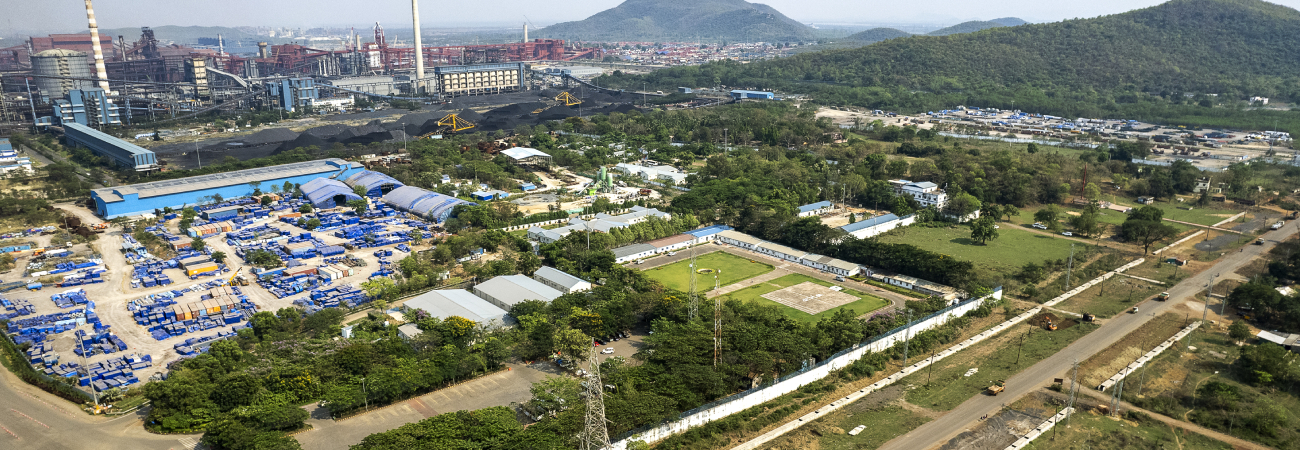
Employing environment-friendly industrial practices at Tata Steel Kalinganagar
Tata Steel’s adopted metrics and targets
Tata Steel has adopted a common and consistent set of emission metrices and targets across its global operations.
KPI
- Total emission, Scope 1, 2 and 3, as per the Greenhouse Gas Protocol
- Emission intensity per tonne of crude steel, as per Worldsteel Association methodology
Target
Net Zero by 2045
F.Disclosure
Tata Steel is playing a profoundly positive role in climate action and is one of only six companies recognised by worldsteel (the World Steel Association) as ‘Sustainability Champions.’ It was a founder participant in worldsteel’s Climate Action programme and has been recognised as an accredited Climate Action member ever since. It has developed sector-leading expertise in life cycle assessment (LCA) – a tool that enables it to understand the CO2 impacts of products in holistic terms, taking account of emissions from raw material extraction, through production and use of finished products such as buildings all the way to the end of life. It is the first steel company globally to become an operator of its own Environmental Product Declaration (EPD) programme, through which it produces EPDs that are shared with customers to enable them to understand the carbon and other environmental impacts associated with Tata Steel products. Tata Steel has been recognised by its peers for its excellence in LCA, receiving prestigious awards from worldsteel in three out of the last five years, most recently in 2022.
Tata Steel has a long, unbroken record of annual disclosure to CDP. Its most recent disclosure in 2022 secured a rating of A-, placing it very close to the top within steel sector listings.
Tata Steel’s performance on its key performance indicators has been disclosed in the ESG Factsheet including in the Company’s Integrated Report for FY2022-23.